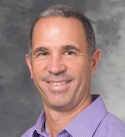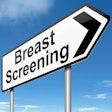
Below is a list of the finalists for the 2016 edition of the Minnies, AuntMinnie.com's campaign to recognize the best and brightest in medical imaging.
The finalists were drawn from a list of 215 semifinal candidates in 14 categories, based on nominations submitted by members of AuntMinnie.com. To see the full list of semifinalists, click here.
One winner will be selected for each category by our expert panel, with final winners announced in October. To vote in our Best Radiology Image contest, go to our Facebook page.
Most Influential Radiology Researcher
Dr. Sanjiv Gambhir, PhD, Stanford University
 Dr. Sanjiv Gambhir, PhD
Dr. Sanjiv Gambhir, PhDNot many radiologists have their own Wikipedia page, but Dr. Sanjiv "Sam" Gambhir, PhD, does. That fact is a testimony to the influence of Gambhir's research on the field of molecular medicine.
Gambhir has been chair of the department of radiology at Stanford University since 2011, but he continues to publish frequently, with a particular focus on using molecular imaging to detect and monitor cancer, including at the cellular level. His name appeared on multiple research papers in 2016, ranging from using different PET radiopharmaceuticals to monitor cancer recurrence to experiments in endoscope-based fluorescence imaging for the early detection of colon cancer.
Picked to be president of the World Molecular Imaging Congress in 2017, Gambhir is also a Minnies laureate, having won the award for Most Influential Radiology Researcher in 2011.
Dr. Perry Pickhardt, University of Wisconsin
 Dr. Perry Pickhardt
Dr. Perry PickhardtDr. Perry Pickhardt is best known for his pioneering work in CT colonography (virtual colonoscopy), in particular a 2003 study that found the virtual technique to be more sensitive than optical colonoscopy for lesions 8 mm and larger in average-risk patients.
But Pickhardt has hardly rested since then, continuing to churn out studies such as an August 22 paper in Radiology that indicates it's probably safe to wait as long as five to 10 years after an initial negative colon screening scan to scan again. His name has also appeared on papers this year exploring topics ranging from data reporting of CT colonography studies to research on the use of CT outside the colon, including imaging of the liver and for appendicitis.
Pickhardt's work could become particularly relevant given the decision in June by the U.S. Preventive Services Task Force to include CT colonography among the tests that are acceptable for colon screening -- a move widely seen as paving the way toward Medicare and Medicaid reimbursement.
Most Effective Radiology Educator
Dr. Frank Gaillard, Radiopaedia
 Dr. Frank Gaillard
Dr. Frank GaillardAs the founder of the website Radiopaedia, Dr. Frank Gaillard has had an inestimable impact on radiology education around the world.
The site was founded in 2005 and now sports over 23,000 patient cases and 9,600 articles, all published with an open-edit wiki style that fosters collaboration between users. Radiopaedia content can thus be progressively updated over time as clinical knowledge changes.
Gaillard is a neuroradiologist and director of research in the department of radiology at the University of Melbourne's Royal Melbourne Hospital. Besides his work as a clinical neuroradiologist, his research interests are in neurodegenerative disease, imaging tumors of the central nervous system, and MRI interpretation with computer-aided tools.
Dr. Pamela Johnson, Johns Hopkins University
 Dr. Pamela Johnson
Dr. Pamela JohnsonAs residency program director at Johns Hopkins, Dr. Pamela Johnson oversees a radiologist training program that is one of the most highly regarded in the U.S. Johnson took over the reins of the department in 2014 and has continued the strong emphasis on training that was established by its founder, Dr. Stanley Siegelman, who ran the department for 35 years (Dr. Karen Horton led the residency program from 2009 to 2014).
Under Johnson, Johns Hopkins has continued with an IT-driven strategy toward residency education, last year rolling out a new dashboard designed to give residents real-time feedback on their performance relative to their peers as well as established clinical and professional benchmarks.
She has also been involved in initiatives at Johns Hopkins to ensure the delivery of appropriate healthcare, serving as the physician lead for the health system's high value care committee, and as director of appropriate imaging.
Most Effective Radiologic Technologist Educator
Joey Battles, American Registry of Radiologic Technologists
 Joey Battles
Joey BattlesJoey Battles has been director of educational eligibility requirements at the American Registry of Radiologic Technologists (ASRT) since March 2012, where he is responsible for the group's initial certification department, which encompasses processing technologist certification applications and reviewing clinical experience requirements.
Before joining the ARRT, he worked at the Joint Review Committee on Education in Radiologic Technology (JCERT), where he was an associate director for more than five years. Prior to that, he was program director of the radiologic technology department at Clarkson College in Omaha, NE.
Diane Kawamura, PhD, Weber State University
 Diane Kawamura, PhD
Diane Kawamura, PhDDiane Kawamura, PhD, has been involved with radiological sciences education at Weber State University for nearly four decades, helping to build the program into one of the most well-regarded in the U.S.
Beginning her career in radiology as a technologist, she joined Weber State in 1978. Since then, the program has grown to the point where it now enrolls the second highest number of students at the university, with over 400 students participating.
Kawamura is the educational director of the department's diagnostic medical sonography program and a frequently published author. She is also past president of the Society of Diagnostic Medical Sonography and a presidential distinguished professor at Weber State.
The department is celebrating its 50th anniversary this year -- an accomplishment that Kawamura has helped make possible.
Most Effective Radiology Administrator/Manager
Martin Bledsoe, Johns Hopkins University
 Martin Bledsoe
Martin BledsoeMartin Bledsoe helps keep the wheels turning at Johns Hopkins Russell H. Morgan Department of Radiology and Radiological Science, no easy task in a department where radiologists read 750,000 cases a year.
Bledsoe has been administrator of the department since 2000, managing an operation that has a staff of 1,500 with $280 million in operating expenses. He was named president of JHImaging in 2014, where he achieved volume growth of 39% from 2014 to 2016, with an operating margin of 22%.
In addition, Bledsoe has been responsible for a number of improvements at the department, such as helping to establish its Future Leaders program, which picks frontline employees for additional training to provide a development track for future career growth.
Charles Powell, PhD, Emory University
 Charles Powell, PhD
Charles Powell, PhDCharles Powell has been involved in managing medical imaging operations at Emory Healthcare for the past 14 years. Currently vice chair and executive director at Emory Healthcare, he manages radiology operations at 18 Emory locations in Georgia, ranging from clinics to hospitals.
Powell entered healthcare in 1993 after serving in the U.S. Air Force. He directed support services at Emanuel Medical Center in Turlock, CA, and then worked for four years as group director of medical imaging at healthcare provider HCA.
He received his PhD in leadership and change in 2014, and in November 2015 he was named an adjunct assistant professor at Emory University, where he conducts learning sessions and provides coaching on leadership development and change management.
Best Radiologist Training Program
American College of Radiology (ACR) Radiology Leadership Institute, Reston, VA

The ACR's Radiology Leadership Institute (RLI) is a relative newcomer on the scene, having been created just five years ago. But the program has already established a reputation for itself, as evidenced by its selection as a finalist for a Minnies 2016 award for Best Radiologist Training Program.
The ACR formed the institute to provide an avenue for radiologists who might not have access to leadership training at their home institutions. The group sees such training as a key element in helping radiology stay competitive with other medical specialties in the increasingly zero-sum environment of healthcare policy.
The institute offers a variety of training offerings, from in-person meetings and events to online programs that participants can pursue while holding down their day job. The program is structured with four different levels designed to match radiologists who are at different stages of their careers.
The program's curriculum ranges from finance and economics to service quality and safety; RLI participants can receive credit toward a Master of Business Administration (MBA) degree thanks to the ACR's partnership with Babson College in Wellesley, MA.
Duke University, Durham, NC
 Duke University
Duke UniversityDuke University consistently ranks as one of the top 10 radiology residency programs in the U.S., so it's not surprising that the program made the final cut in the 2016 edition of the Minnies for Best Radiologist Training Program.
Led by department chairman Dr. Erik Paulson, Duke Radiology focuses on training radiologists to be well-prepared for careers in either academic or private-practice radiology. Radiology is also a required clerkship for every medical student at Duke University.
Training 12 residents per class under the leadership of residency program director Dr. Karen Johnson, the program offers a five-year combined residency and fellowship program in a "3/2" structure, which allows for more than three years of training in general diagnostic radiology and two years of education in a subspecialty area. Duke believes the format enables it to create radiologists who are "strongly grounded in general diagnostic radiology," with almost double the amount of subspecialty experience.
While education is a major priority, the program is also known for cutting-edge research. Recent papers produced by Duke faculty include studies on how often smokers should receive CT lung cancer screening, the effectiveness of guided meditation to reduce harms during breast biopsy procedures, and digital chest tomosynthesis for lung imaging.



















